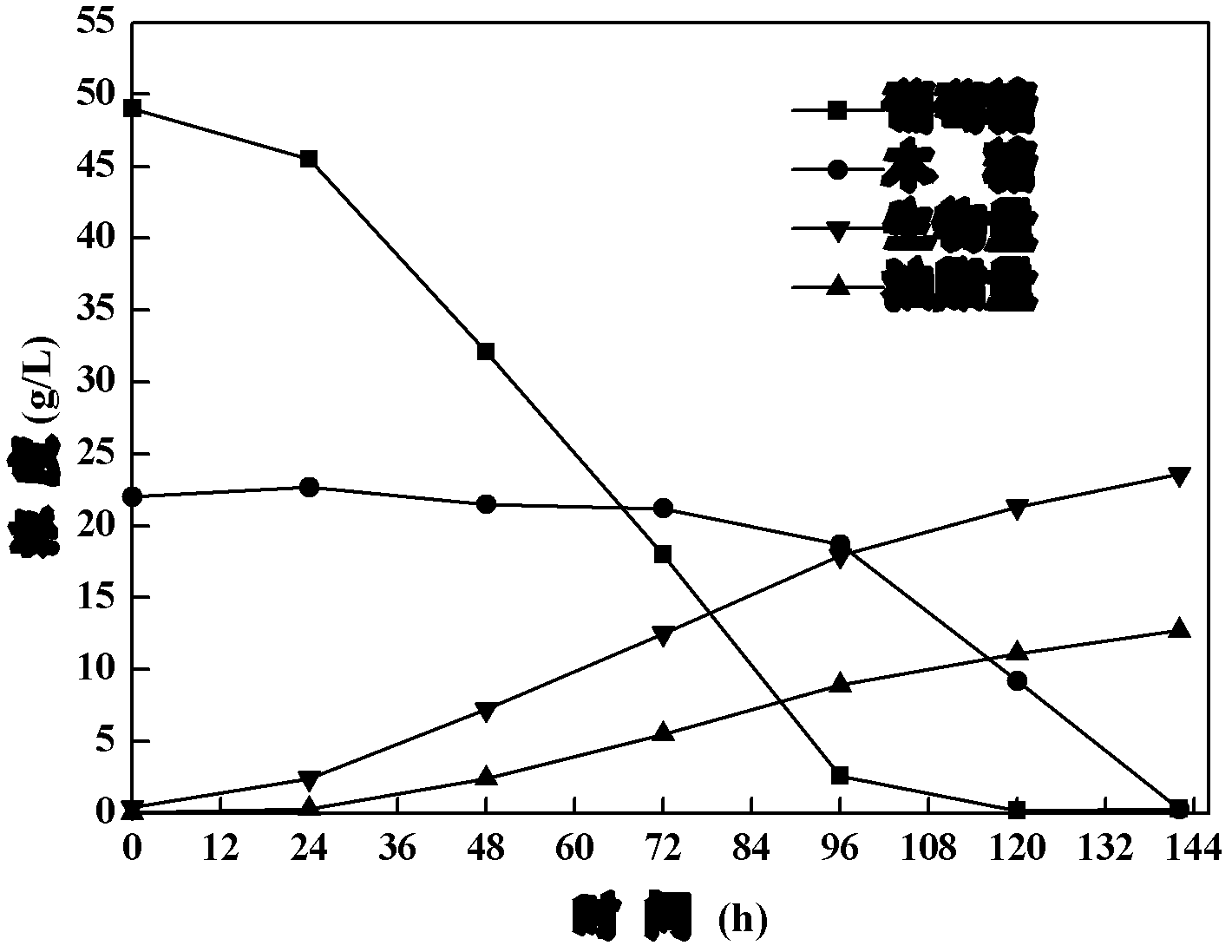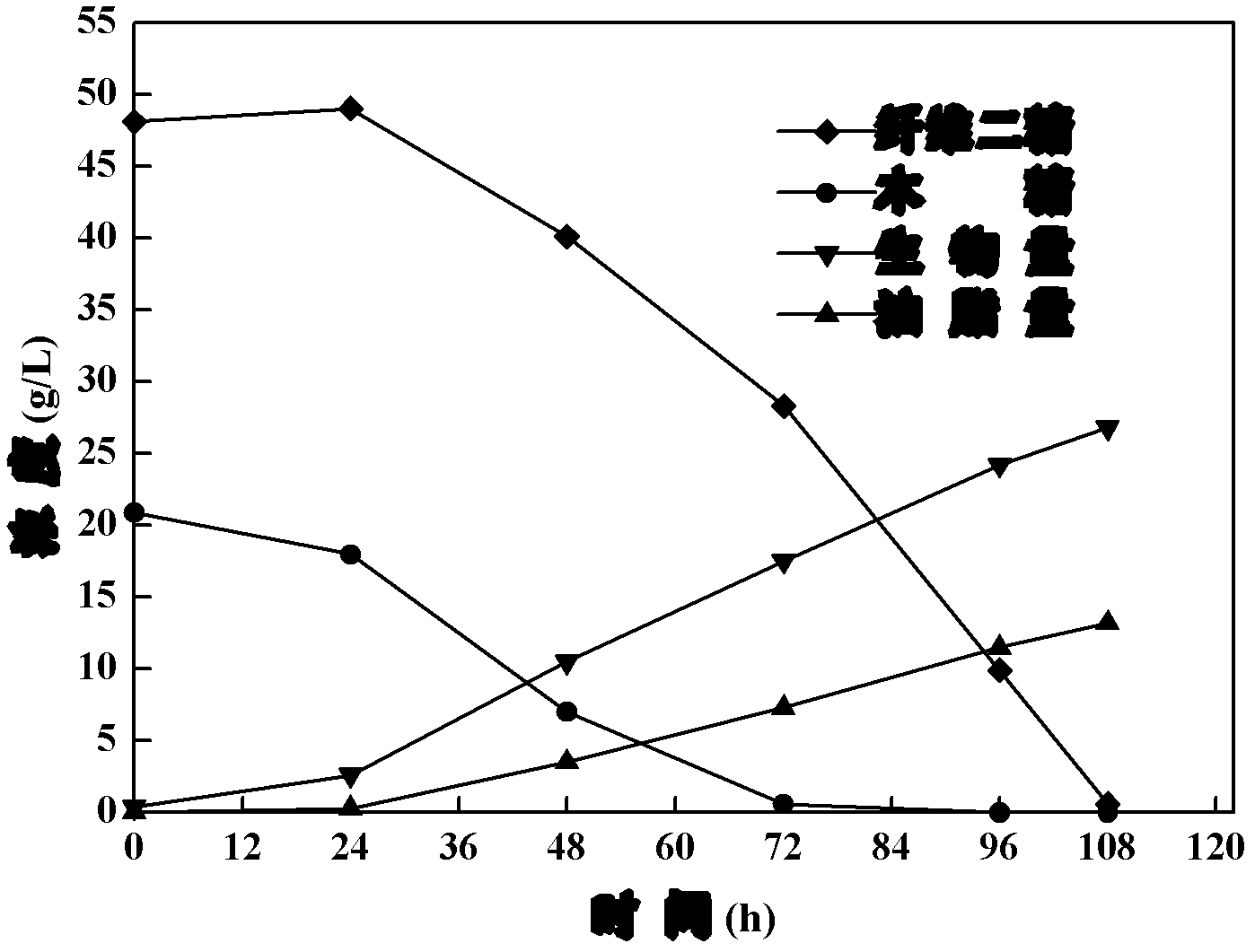Oil production microbe culture method
A technology for oleaginous microorganisms and microbial cultivation, which is applied in the field of oleaginous microorganism cultivation, can solve problems such as lack of universal practicability, and achieve the effects of shortening the fermentation cycle, improving sugar utilization efficiency, and reducing costs
- Summary
- Abstract
- Description
- Claims
- Application Information
AI Technical Summary
Benefits of technology
Problems solved by technology
Method used
Image
Examples
Embodiment 1
[0035] 1) Prepare cellobiose and xylose into a mixed sugar solution, cellobiose 47g / L, xylose 23g / L, add 0.5g / L yeast powder, 1.0g / L ammonium sulfate, 1.0g / L heptahydrate sulfuric acid Magnesium, 1.0g / L dipotassium hydrogen phosphate, the balance is water, pH 5.8, and the obtained culture medium is sterilized at 121°C for 15 minutes before use;
[0036] 2) Lipomyces starkeyi AS 2.1560 was cultured in YEPD liquid medium (glucose 20g / L, yeast powder 10g / L, peptone 10g / L) at 30°C and 200rpm for 40h to obtain seed liquid;
[0037] 3) Add the oleaginous microorganism seed solution prepared in step (2) to the culture medium described in step (1) (containing 10 7 living cells), the inoculum size was 10% (v / v), and cultured under aeration at 30°C for 108h;
[0038] 4) Terminate the fermentation. At this time, the residual cellobiose and xylose concentrations in the fermentation broth are respectively 0.5g / L and 0g / L. During the fermentation process, the cellobiose and xylose concentr...
Embodiment 2
[0041] 1) Prepare cellobiose and xylose into a mixed sugar solution, cellobiose 35g / L, xylose 35g / L, add 0.5g / L yeast powder, 0.5g / L ammonium sulfate, 1.0g / L heptahydrate sulfuric acid Magnesium, 7.0g / L potassium dihydrogen phosphate, 2.0g / L disodium hydrogen phosphate, the balance is water, pH 5.5, and the obtained culture medium is sterilized at 121°C for 15 minutes before use;
[0042] 2) Sporobolomyces roseus IAM 13481 (purchased from Japan JCM Strain Collection Center) in liquid seed medium (glucose 40g / L, ammonium sulfate 5g / L, yeast powder 0.5g / L, potassium dihydrogen phosphate 1g / L, Magnesium sulfate heptahydrate 0.5g / L), 30 ℃, 200rpm shaking culture 24h, obtain seed solution (contain 5 * 10 6 living cells);
[0043] 3) Add the oleaginous microorganism seed solution prepared in step (2) to the medium described in step (1), the inoculum size is 15% (v / v), and aerated culture at 30° C. for 103 h;
[0044] 4) Terminate the fermentation. At this time, the residual cellob...
Embodiment 3
[0046] 1) Prepare cellobiose and xylose into a mixed sugar solution, cellobiose 23g / L, xylose 47g / L, add 1.0g / L yeast powder, 2.0g / L ammonium sulfate, 0.5g / L heptahydrate sulfuric acid Magnesium, 2.0g / L dipotassium hydrogen phosphate, the balance is water, pH 4.0, and the obtained culture medium is sterilized at 121°C for 15 minutes before use;
[0047] 2) Geotrichum robustum CICC 1256 (purchased from China Industrial Microorganism Culture Collection Management Center) in YEPD liquid medium (glucose 20g / L, yeast powder 10g / L, peptone 20g / L), 28°C, 200rpm Shake culture for 28 hours to obtain seed liquid (containing 8×10 5 living cells);
[0048] 3) Add the oleaginous microorganism seed solution prepared in step (2) to the culture medium described in step (1), inoculum size 5% (v / v), and aerobically culture at 28° C. for 120 h;
[0049] 4) Terminate the fermentation. At this time, the residual cellobiose and xylose concentrations in the fermentation broth are respectively 0.5g...
PUM
 Login to View More
Login to View More Abstract
Description
Claims
Application Information
 Login to View More
Login to View More - R&D
- Intellectual Property
- Life Sciences
- Materials
- Tech Scout
- Unparalleled Data Quality
- Higher Quality Content
- 60% Fewer Hallucinations
Browse by: Latest US Patents, China's latest patents, Technical Efficacy Thesaurus, Application Domain, Technology Topic, Popular Technical Reports.
© 2025 PatSnap. All rights reserved.Legal|Privacy policy|Modern Slavery Act Transparency Statement|Sitemap|About US| Contact US: help@patsnap.com


